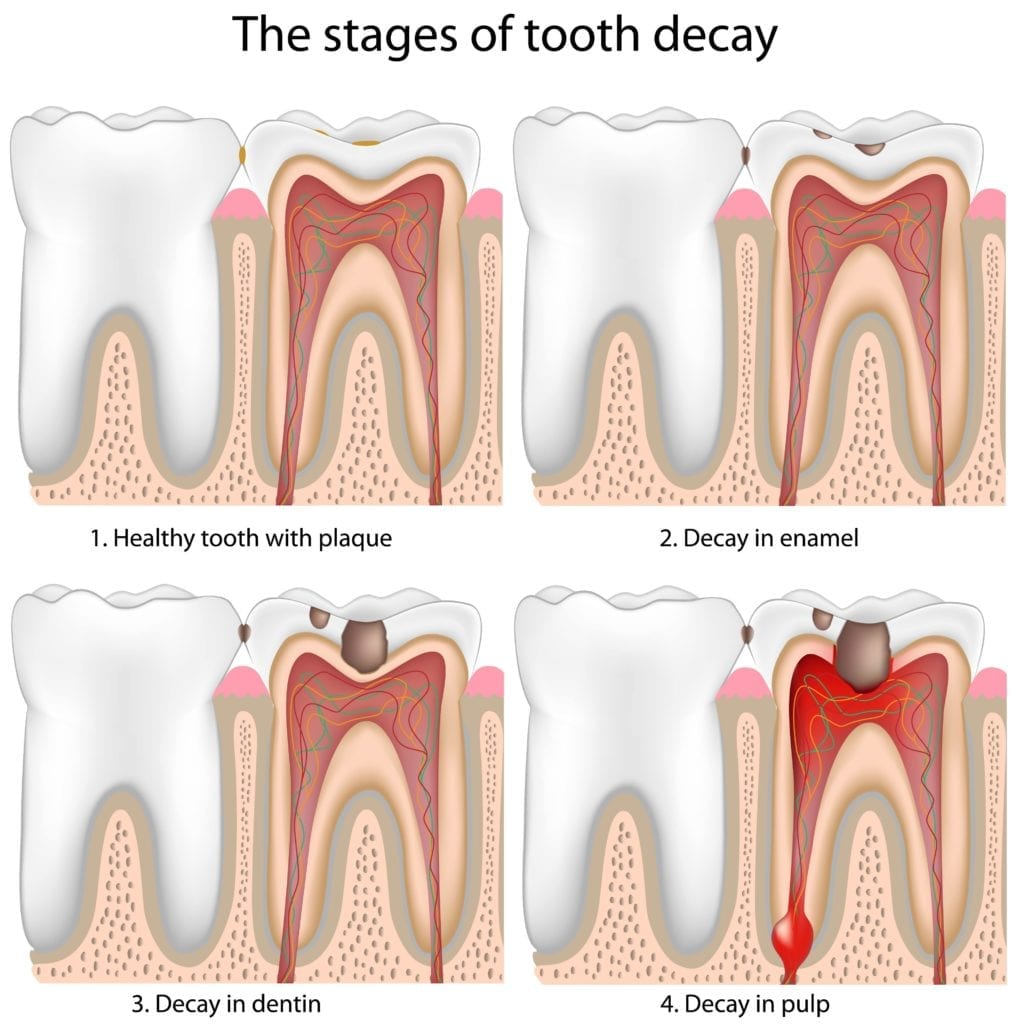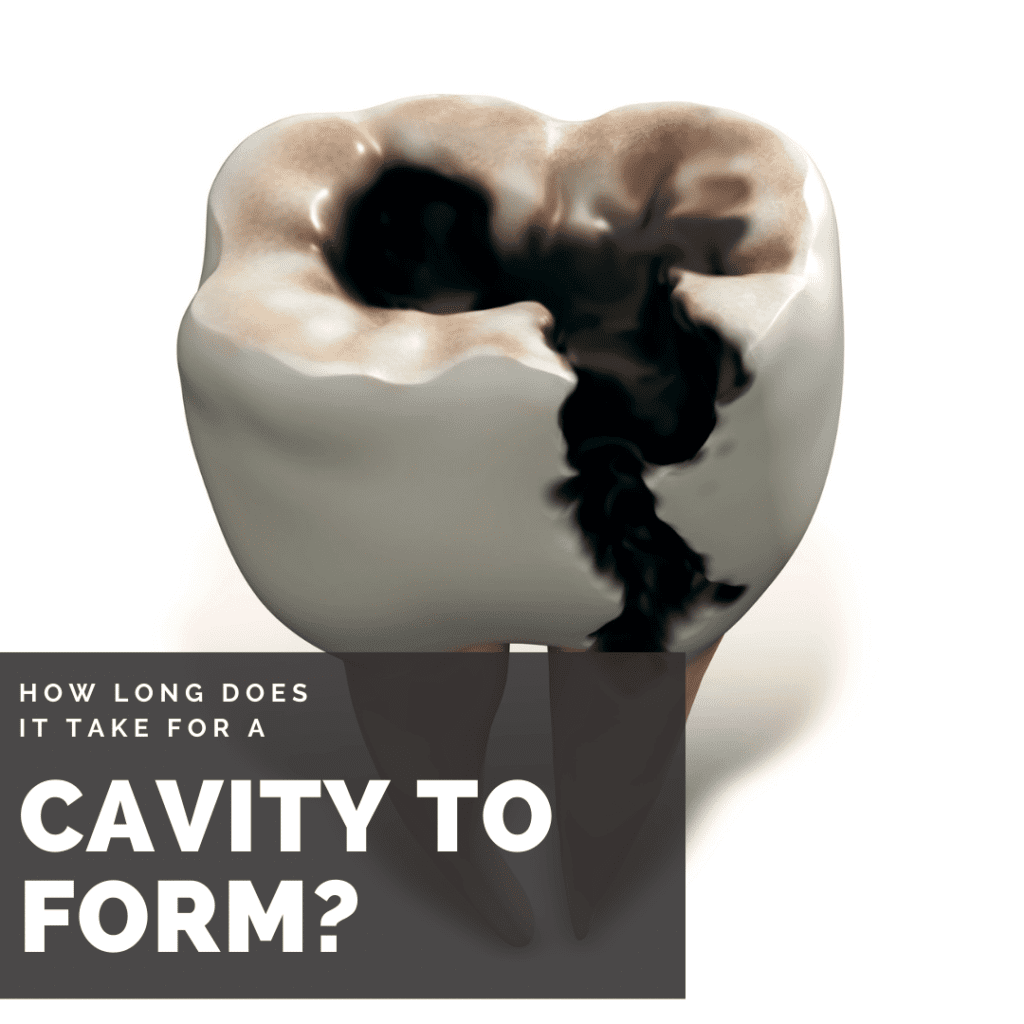Tooth decay, more commonly known as a cavity, is the reason for various restorative dental treatments such as fillings and root canals. Not only is tooth decay one of the most common dental problems your dentist tries to protect you from, but it can also be the reason for premature tooth loss or the need for a tooth extraction. Of course, not all cavities are so severe that a tooth extraction is warranted. In fact, cavities develop over time and can easily be treated before they become severe. So, just how long does it take a cavity to form? In order to answer this question, we must take into consideration what cavities are and how they form. While there is no one size fits all type of answer, learning more about cavities can provide us with insight into just how long it takes for a cavity to develop.

For starters, a cavity is a hole in the tooth that occurs when acids from the bacteria erode the tooth surface. These bacteria reside in the sticky, clear film known as dental plaque and feed on sugars from the food particles that also become trapped in plaque. Although these bacteria are naturally-occurring, feeding on sugar allows their population to grow. This is problematic because bacteria convert the sugars in foods into acidic waste that damages enamel. Over time when acidic waste is consistently deposited onto one particular area, the enamel will eventually start to erod and a cavity will form.
Cavities can form in different locations on the tooth and are named according to where they form. There are three types of cavities known as: pit and fissure, root, and smooth-surface.
- Pit and fissure: this type of cavity is named for the pits and fissures on the textured chewing surface of molars and premolars. This tends to be a very common location for cavities since it is easy for plaque and food particles to become trapped within these pits and fissures.
- Root: this type of cavity forms on the tooth roots in cases where the gums have receded. Since tooth roots have a thinner layer of enamel then the rest of the tooth, they are especially prone to cavities when they are not protected beneath the gums.
- Smooth-surface: this type of cavity forms on the smooth surface of teeth, such as the front, back, or sides. Since it is harder for plaque to stick to smooth surfaces and easier to clean smooth surfaces, this type of cavity is not as common as the other types.
Although cavities can form in different locations on the teeth, they still follow the same pattern in how they form. Specifically, cavities are described in five different stages, including:
Stage 1: Demineralization
Since tooth enamel is primarily composed of minerals, the first step to cavity formation is the loss of minerals. This is known as demineralization and it is characterized by white spots on the teeth where the enamel has started to break down. When demineralization is caught early, there is a chance that the damage can be reversed with fluoride treatments. This is because fluoride helps to build up the minerals lost by demineralization.
Stage 2: Enamel Decay
When demineralization is not caught in time, however, the acid from bacteria will begin to erode the enamel and form a small to medium cavity. Enamel cavities only affect the tooth enamel and can be easily treated by placing a composite filling.
Step 3: Dentin Decay
Without treatment, the acids will continue to erode through the enamel until they reach the dentin layer that lies underneath the enamel. Two things tend to happen at this point. First, pain or sensitivity may be felt. Second, the rate of decay increases since the dentin layer is not as strong as the enamel and is easier to erode. At this point, the cavity has likely grown in size and will need to be restored with larger fillings like inlays or onlays, or even a possible dental crown.

Step 4: Pulp Decay
After passing through the dentin layer, bacteria will invade the innermost layer of the tooth known as the pulp layer. The pulp layer contains both blood cells and the tooth nerve. Unfortunately once bacteria has reached the pulp, it will cause an infection to form inside the tooth that causes significant pain. At this point, the only way to restore the tooth is to perform a root canal in order to remove the infection. The affected tooth will then need to be restored with a dental crown.
Step 5: Abscess
Once the pulp layer has become infected, there is a chance that the infection will move down into the tooth roots through the root canals. This causes an abscess to form at the base of the tooth. Not only is this extremely painful, but most cases require a tooth extraction at this point.
In most cases, it takes years for a cavity to develop, but it is possible for them to develop in a matter of months. The reason why there is not one single answer is because how fast or slow a cavity develops depends on factors such as where the cavity is located, diet, and oral hygiene. As mentioned above, there are certain locations where it is more common to get cavities due to excess plaque accumulation. Unfortunately, this plaque also makes the progression of the cavity faster. This is why pit and fissure cavities progress faster, while smooth-surface cavities generally progress at a slower rate.
Diet also plays a role in how fast a cavity develops. Eating more sugar on a regular basis means that any cavities will grow faster, while decreasing sugar intake can decrease the rate at which a cavity progresses. Finally, oral hygiene habits play another important role in how long it takes for a cavity to develop. Generally speaking, people who brush twice a day, floss daily, and visit their dentist every six months have less plaque, which means less bacteria and a slow progression of cavities. Conversely, skipping out on brushing, flossing, or dental cleanings can cause more plaque and bacteria to build up, which speeds up the progression of cavities.

Dr. Admar holds dual certificates — a Bachelor of Dental Surgery (BDS) in 2010 from India and a Doctor of Dental Surgery (DDS) in 2014 from Canada. He is now a full time practicing dentist in Kamloops where he provides a variety of services. Dr. Admar spends hundreds of hours in continued dental education to stay up to date in cosmetic and implant dentistry and he has achieved several advanced qualifications.


